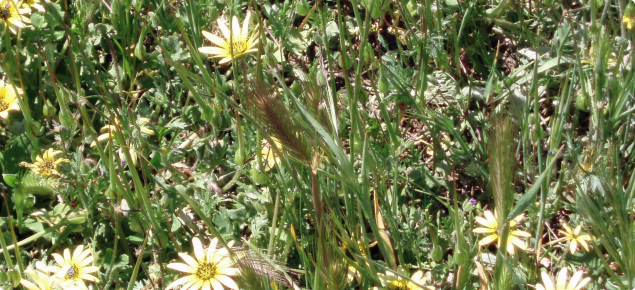Herbicide choice
Grass selective herbicides (Group A) are commonly used to control ryegrass, barley grass and brome grass. The Group A herbicides have little or no effect on silver grass and they are often mixed with simazine, to increase the spectrum of grasses controlled. The Group A herbicides were the first to develop herbicide resistant annual ryegrass populations and as a result may have little effect against annual ryegrass. They are still effective against barley grass and brome grass.
For simazine (Group C) to be most effective there must be some contact between the herbicide and the soil so that root uptake can occur. Adequate soil moisture is required to ensure simazine becomes active. Early application or good rainfall is required to ensure the success of this treatment.
Propyzamide (Group K) is another root active herbicide that requires good soil moisture to be effective. Propyzamide will control a wide range of annual grasses, including silver grass, with no damage to the clover pasture. This product has a long withholding period for grazing, 25 days.
Herbicide rates
Herbicide rate will depend on the size of the weeds to be controlled and their age. A grass that looks small may have been growing for a long time and have a well developed root system and will be harder to kill as a result. Generally, the 2-5 leaf stage of the grass is the best time for economical control. The grass density is also important as adequate coverage of the foliage with chemical needs to be ensured, with a thick grass stand increase the water volume to get good coverage. Weather conditions may also influence chemical uptake and speed of kill.
The efficacy of simazine will depend on the soil type. On very light sandy soils effective silvergrass control may be possible with the lower rate in the range specified on the label. While heavier soils, loams and light clays may need the higher rate stated. High rates of simazine (1.5L/ha) can be detrimental to clovers, causing stunting or burning, particularly on the heavier soils.
It is essential to read the label before use, even if you have used the chemical before as formulations can change from year to year.
Always check the withholding period for grazing. Some products, such as propyzamide, have a 25 day withholding period. The withholding period may also vary for grazing or cutting fodder.
Points to note
- Ensure adequate pasture nutrition and insect control following pasture manipulation. This gives the legume a competitive edge over any grasses which may remain following treatment.
- Severe insect attack may cause the effects of herbicide treatments to appear more damaging.
- Clover should be evenly distributed over the paddock and make up at least 30% of the pasture before undertaking pasture manipulation, otherwise bare areas may result.
- Clover growth may be suppressed following herbicide application. It is generally best to apply broad-leaf herbicides separately to the grass herbicide, the separation of the applications is usually 7-14 days (but this can vary with product - read the label).
For more information refer to Use nitrogen fertiliser to boost winter pasture growth, Grazing annual pastures in winter and spring, Grazing sheep at the break of season and Deferred grazing calculator.



